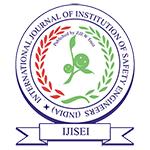Accuracy Effect of Instrument in Safety

Volume 4, Issue 1, January-March 21
Accuracy Effect of Instrument in Safety
Sourav Chakraborty
B.Tech (Elec. Engineering)
Email id: souravc618@gmail.com
Abstract
To measure or detecting safety related parameter, generally use same instruments for different aspects but did not verify its actual use and calibration process and it effect to safety. For maintaining proper safety aspects, need to use proper calibrated instruments and those instruments to fit for that work. In this Study, Accuracy of Instrument is described and use of suitable instrument or devices recommended for proper work to avoid any incorrect result or prevent error. Results error create un-accepted circumstances and results obstacles to eliminate or rectify to safety related deficiencies.
Key word: Accuracy of instrument, Proper device for proper work, Instrument differentiation.
1. Introduction
Safety or Health, Safety & Environment (HSE) term is very much famous with industrial instruments or equipment’s which are used in daily basis to measure or to maintain every parameter that are directly linked with SAFETY. To fulfill the audit criteria or to maintain the checklists, various time instruments are used that are not suitable for that work or the fittings connected with that instrument is not as much suitable to maintain the safety environment.
To reduce cost, maximum time it is observed that vendor used same instruments in various work but the respective instrument gives accuracy only for the one work not for others. From here the safety violation started and this create gaps in organization safety system during looking actual condition of work environment such safe value of oxygen value, LEL etc. Here this will be discussed that how can reduce this violation and to increase the awareness regarding that.
2. Accuracy of Instrument
Accuracy of instrument is defined when it is calibrated and tested with the suitable or similar equipment’s and tested on regular interval. There will be some error percentage or deviation with the actual value defined. We have to maintain that error percentage or accuracy level and to verify that after each interval during testing or calibration.
Example: In a product line standard Pressure gauge is there for 0—6 kg/cm2. During calibration we have to check by portable master calibrator by giving pressure to PG whether this PG giving exact reading like master calibrator or any deviation comes. If any deviation find with the master calibrator, this must be note down and to maintain in calibration certificate respectively. After every interval this deviation must be check and if any changes find same must be recorded. If difference comes more than permissible limit then the equipment’s to replace for safety reason. Also, to remember that this PG (0—6 KG/CM2) can be used only up-to (6 kg/cm2) operation able line not more than this.
3. Accuracy in Safety
In Safety, accuracy play major role in every aspect. If we use (0-500) volt voltmeter to check the voltage measurement, the actual voltage in line is 440 volts but in meter it is showing 400 volts. (+40) volts difference will be critical for some industry. Different relay may get tripped but due to accuracy issue the actual issue of tripping can’t get identified.
Another example is LEL meter to use for measurement of LEL level or percentage of LEL. Max time we use it to check for O2 level. For O2 measurement different meter is available in market. This is our lack of awareness. For particular work we have to use certified equipment’s to maintain safety.
If we don’t calibrate the equipment for long time this will also affects our safe environment and may some incident or accident happen. In a 0—10 bar PT if deviation comes and we simply neglect that then after some days something going to happen and that will be not safe.
3.1 Effects
The following effects may arise due to accuracy issue of equipment and not to use proper equipment as mentioned below:
- Unsafe situation or unsafe condition may arise
- Any near miss can happen
- Reportable accident may also happen
- LTI (Loss time injury) may take place
- Major accident also take place
- Safety culture or safety environment will not be there
3.2 Solutions
Following steps to be followed to resolve the issues:
- Calibration to be done by proper test kit
- Testing checklists to be maintain
- Interval of checking to be maintain
- If any deviation comes, record to be maintain
- Proper equipment must be use work-wise to get accuracy.
- Awareness is most important and use instrument as per manufacturer recommendation
4. Example

5. Conclusion
Accuracy effects of instrument always impacts to Safety system of organization. Correct accuracy gives positive results and actual condition such as Oxygen level in work environment. This also helps to seek improvement if any deficiency in organization on based of recorded results of instruments and few major factors to ensure accuracy of instrument are:
- We have to identify suitable and standard instruments or equipments as per work.
- Calibration/Inspection/testing schedule to maintain.
- Proper checklists to be maintain.
- Area/Zone wise instruments to use.
- Deviation/error to update in calibration sheet.
Reference:
- K.U Mistry (Fundamentals of industrial safety and health)
- J.B Gupta (Instruments measurement)
- B.L THERAJA (Basic electrical & electronics)
- Google, Wikipedia
- ISEI Manual
